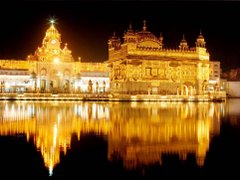Saturday, March 13, 2010
Should the Sikhs Eat Meat?
Recently, I had a chance to watch the rather barbaric movie, “The Cove’. As you all know, it describes vividly (leaving nothing much to your imagination) how dolphins are massacred to serve the palate of a few. And I thought SAW was the only barbaric movie I had ever seen. Let us not go off topic here. I also watched some clippings on YouTube of how different animals raised for meat are treated. Chicken, cow, veal, pig, ducks all sorts of them. All these years we thought that these animals were injected with hormones to mature them faster and increase their muscle mass. Now it seems a new wave of animal raising has arrived. These animals are force fed. So a long feeding tube is shoved through the mouth right into the stomach of the animal and feed is pushed down. This forced feeding, irrespective of whether the animals wishes to eat or not, makes the animal grow faster. The animals are cramped together and occasionally restricted on purpose from moving around. This reduces the amount of calories they burn and hence all the food they consume is converted into fat/muscle. The condition of these animals is unimaginable. Normally, their weight crushes their legs and they become sedentary anyways.
This made me revisit the Sikh philosophy of Jhutka. As suggested by many (I have no clue where the concept of jhutka came from), the basic purpose of jhutka is to save the animal from pain and suffering and hence our avoidance of Halaal. With all the barbarism that goes into raising animals for meat, where does it leave our concept of jhutka? After all what we consume is either processed meat or cleaned meat sold at grocery stores. We gave ‘The Cove’ an Oscar as it suits our sensibilities but we continue to consume the force fed animal meat. We continue to entertain ourselves by forcing dolphins to dance to our tunes as this torture is not against our sensibility. Bhagat Kabeer ji says, “pati tore malini, pati pati jeeyoh, jis pahan ko pati tore so pahan nirjio”. The flower girl worships a stone idol by offering flowers. Little does she realize that every single petal of the flower is alive with life but the idol she tries to please by offering those petals is non-living. He further says, "brahm pati bisn dari fuul shankar dhaeo, teen dev prtakh toreh kareh kis kii saeo". Brahma is in the leaves, Vishnu is in the branches and Shiva is in the flowers. When you break all these three Gods, who are you serving? "Pakhan gadd ke murat kini deh keh chatti pav, je eh murat sachi heh tu garranhareh khau". The sculptor carves the stone to make an idol by keeping his feet on the stone. If this stone was God indeed, HE would devour the sculptor for disrespect.
Every single day we waste our energies on countless rituals of jhutka, halaal, kosher etc never pausing once to reflect if our actions are indeed pleasing the lord almighty we claim to serve. We do not hesitate to reference Guru Gobind Singh ji in our discussions on consumption of meat but forget the steel bracelets he blessed us with, Reminders of our being slaves of the creator. We only serve our palates and in a larger perspective, our vested menial personal interests, of which we have become slaves.
Food and Sikhs
A colleague/friend came over to the gurdwara and spoke about the effect of our dietary habits on our health. Yes, we are talking of our own Sikh community and all the jalebis and samosas we eat in snacks. We always top these up with food cooked in clarified butter with heavy masaala tarka. Our hospitality is incomplete if this is not followed by dessert of saweein or kheer or gulab jamuns. As the mouth savors all this, we overcome our guilt by consoling ourselves that we will soon burn all this on our fancy treadmills or through gym memberships. Fortunately for the treadmill and unfortunately for us, that day never arrives. The cholesterol in our diet, meanwhile, is busy lining our arteries and obstructing the smooth flow of blood to our heart, brain and other parts of the body. And when we find it hard to climb a flight of stairs, we conveniently take the elevator. Soon our vegetative existence forces us to see a doctor who after running some fancy tests on us declares that we have heart disease due to elevated cholesterol, triglycerides and what not. We start consuming loads of cholesterol reducing medicines hoping it would go away.
What we never realize is that we can do away with all this if we exercise regularly and decrease the serving size of our food. Needless to say, if we could steam instead of frying our food, it would do wonders. Ofcourse, we could have saved ourselves from all this if we had listened to our Guru in the first place. I chanced across this wonderful article from Dr. IJ Singh and thought of sharing with you. I would let him do rest of the talking and save some calories myself by not typing away.
Taboo or Not Taboo ... That is the Question ...by I.J. SINGH
The first response to the title of this essay is predictable: certainly there are no food taboos in Sikhism.
This is after all a young, modern, vibrant faith, very practical in its doctrines and sensible in its beliefs. But there is always a hooker.
What set me thinking about food restrictions was something that happened about twenty-five years ago; I have heard periodic echoes of the issue over the years. For about three months, I was the Secretary of our major, and at that time the only, gurdwara in New York. We used to meet once a month, then it became once a week.
More regular in attendance than any others were some young, single Sikhs, mostly students, living in the city. I think what attracted them was the socializing and the free community lunch that always followed the service. I could relate to that and to them. Often we would spend half a Sunday at the gurdwara and then gather at someone's apartment to shoot the breeze and solve the problems of the world.
One day a group of young friends volunteered to provide the community lunch following the weekly service. Of course, they would not prepare a traditional meal but offered to serve ham and cheese sandwiches instead. I thought it was a great idea. When I broached the management committee however, all hell broke loose. How could I think of sandwiches, I was asked? I offered pizza but the reaction was not much better. I was told in no uncertain terms that the meal must be a simple Punjabi meal - vegetables, beans, unleavened flat bread (chappaties). Rice could be added or substituted for the bread, if necessary. Accompaniment of pickle and a good dessert would round up the menu. The preparations did not have to be simple and, depending upon the host, could be elaborate, but the menu was to be strictly vegetarian and under no circumstances was it to depart substantially from the traditional Punjabi meal.
I too adore Punjabi food and more so with each passing year that I live outside a Punjabi milieu. But I wonder at the unwritten code on food proscription that seems to operate at Sikh gatherings. Where in Sikh history or theology does it say that all meals are to be vegetarian or prepared in a particular way? And following religious services at homes I have partaken of community meals which were so extensive and elaborate that they would rival the spread at the fanciest restaurant.
Such a feast raises the obvious question: Is that what the Guru intended when he initiated the concept of a community meal (langar) following a religious service?
History provides us some sensible ways of looking at what we believe and what we actually do.
Indeed Sikhs observe no food taboos as are found among the Jews, Muslims or Hindus, among others. Of the two dominant religions in India, the Hindus eat no beef while the Muslims will not come near pork. The Sikhs find common ground by finding both kinds of flesh acceptable. It is true nevertheless, that a great majority of Sikhs do not eat beef since many of them come from a Hindu background. In fact in Punjab, before India was partitioned in 1947, neither beef nor pork was easily available in deference to the strong beliefs of the two majority religions. Also many if not most Hindus are obligatory vegetarians. Observing Jains eat no eggs or onions either.
Consequently, most Sikhs never acquired a taste for either beef or pork but are content with chicken, mutton or lamb. Landlocked Punjab does not have much of a variety in fish, but it is enjoyed in the limited quantity that it is available.
Throughout Sikh history, there have been movements or subsects of Sikhism which have espoused vegetarianism. I think there is no basis for such dogma or practice in Sikhism. Certainly Sikhs do not think that a vegetarian's achievements in spirituality are easier or higher. It is surprising to see that vegetarianism is such an important facet of Hindu practice in light of the fact that animal sacrifice was a significant and much valued Hindu Vedic ritual for ages.
Guru Nanak in his writings clearly rejected both sides of the arguments - on the virtues of vegetarianism or meat eating - as banal and so much nonsense. Nor did he accept the idea that a cow was somehow more sacred than a horse or a chicken. He also refused to be drawn into a contention on the differences between flesh and greens, for instance.
History tells us that to impart his message, Nanak cooked meat at an important Hindu festival in Kurukshetra. Having cooked it, he certainly did not waste it, but probably served it to his followers and ate himself. History is quite clear that Guru Hargobind and Guru Gobind Singh were accomplished and avid hunters. The game was cooked and put to good use, to throw it away would have been an awful waste.
Sikhs also do not respond to the Semitic commandment on avoiding animals with cloven hoofs. And one Semitic practice clearly rejected in the Sikh code of conduct is eating flesh of an animal cooked in a ritualistic manner; this would mean kosher and halal meat. The reason again does not lie in religious tenet but in the view that killing an animal with a prayer is not going to ennoble the flesh. No ritual, regardless of who conducts it, is going to do any good either to the animal or to the diner. Let man do what he must to assuage his hunger. If what he gets, he puts to good use and shares with the needy, then it is well used and well spent, otherwise not.
The community meal (langar) that the Sikhs serve in their gurdwaras has several purposes. Much of India even now is bound in traditions of caste. In the Hindu caste system, the high and the low castes do not mix socially, do not eat from the same kitchen. The food of a Brahmin is considered defiled if the shadow of an untouchable or a Muslim falls upon it.
Sikhism set out to break these barriers. In the gurdwara, the meal is served to people who sit in a row. You may not chose who to sit next to; it may even be an 'untouchable'. You may not ask to be served by someone special. The food is prepared by volunteers from the community in a community kitchen. Men, women and children, rich and poor alike, work together to cook and to serve.
This is also where young and old, children and adults, learn the concept of service. The food is available to all; kings and the homeless have partaken of it. Emperor Akbar who ruled India in the sixteenth century enjoyed such a meal. In this country, most gurdwaras do not have langar service operating all day but one that serves only one meal at the conclusion of a service. Therefore, whatever food is left over is either carted home by those who wish, or is delivered to a center for the needy.
In the sixties many hippies trekking through India found gurdwaras an easy place for a quick and free meal; countless homeless people enjoy this Sikh hospitality every day. It is a way for the ordinary Sikh to thank God from whom all blessings flow. Service to the needy and sharing one's blessings with others is a cornerstone of the Sikh way of life and it starts in the community kitchen. It is a recognition of the principle that even God has little meaning or relevance to an empty belly. The prayers of the congregation and their spirit of service make the meal special, not the variety in the menu.
The usual menu in a gurdwara is simple - one vegetable, some beans, a handful of rice and one or two pieces of flat bread (chappaties). This is what the poorest people in Punjab eat. The ingredients are what the simplest home in Punjab would have. Fancier dishes are avoided even if one can afford them for the purpose is not to instill envy in others or to show off one's own riches. If meat is avoided, it is not because of any canon but because the menu should be such that everybody can afford and anybody can eat; something nobody will have any compunctions or reservations about.
Remember that gurdwaras are open to all and often frequented by Hindus and Muslims alike. The menu for the langar at the gurdwara has to provide the least common denominator in the local cultural tradition.
I have heard there are a few, rare gurdwaras in India where meat is served at times. I emphasize that such gurdwaras are few and in them, service of meat is rare. I suppose the practice started sometime ago for certain historical reasons and has continued. No harm in it as long the people coming there are aware of it.
It is not a matter of Sikh doctrine but of consideration for others and common sense. Some historians contend that meat was often served in langar at the time of Guru Angad. History has it that Guru Amar Das, well before he became a Guru, visited Guru Angad. On that day, some Sikh had donated a large quantity of fish which was being served in the community meal. Amar Das had been a devout Hindu and a vegetarian until that time. Some historians say that he was somewhat squeamish about it but, now that he had become a Sikh, accepted the fish as a gift from the Guru's kitchen.
Others suggest that Guru Angad, knowing full well that Amar Das was a vegetarian, directed the sevadars not to offer him the fish. Considering the love of nature and of God's creation in the writings of the Gurus, wanton killing of animals would not be condoned, not would be their ritual sacrifice for gustatory satisfaction or otherwise.
There are other benefits to a simple but sufficient lunch after a service. The attendees know that they do not have to rush home and feed the kids or themselves. The mind is not distracted by the chores waiting at home; time off from them is a welcome respite, however brief. One can relax and enjoy the service single-mindedly.
Hindus have often debated if what you eat determines your spiritual status. Sikhs do not believe that. With such practical and liberal reasoning, some strange and unorthodox practices can also arise. Khushwant Singh speaks of a gurdwara in Australia which serves beer with the food. Given Sikh history and teaching, that just wouldn't do.
In his many writings, Guru Nanak offered only two criteria for food taboos, both are based on common sense. Anything that will harm the body or mind is to be shunned. And all things edible are available and permissible in moderation.
Over the years, I have seen many variations on the theme but to discuss and debate unnecessarily what to eat or not to eat in Sikhism is to transform what a modicum of intelligence and common sense can easily resolve into a mesh with the complexity of the Gordion knot.


